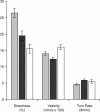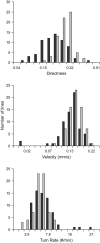Behavioral degradation under mutation accumulation in Caenorhabditis elegans
- PMID: 15834141
- PMCID: PMC1450389
- DOI: 10.1534/genetics.104.040014
Behavioral degradation under mutation accumulation in Caenorhabditis elegans
Abstract
Spontaneous mutations play a fundamental role in the maintenance of genetic variation in natural populations, the nature of inbreeding depression, the evolution of sexual reproduction, and the conservation of endangered species. Using long-term mutation-accumulation lines of the nematode Caenorhabditis elegans, we estimate the rate and magnitude of mutational effects for a suite of behaviors characterizing individual chemosensory responses to a repellant stimulus. In accordance with evidence that the vast majority of mutations are deleterious, we find that behavioral responses degrade over time as a result of spontaneous mutation accumulation. The rate of mutation for behavioral traits is roughly of the same order or slightly smaller than those previously estimated for reproductive traits and the average size of the mutational effects is also comparable. These results have important implications for the maintenance of genetic variation for behavior in natural populations as well as for expectations for behavioral change within endangered species and captive populations.
Figures



Similar articles
-
Spontaneous mutational correlations for life-history, morphological and behavioral characters in Caenorhabditis elegans.Genetics. 2005 Jun;170(2):645-53. doi: 10.1534/genetics.104.040022. Epub 2005 Apr 16. Genetics. 2005. PMID: 15834140 Free PMC article.
-
Mutation Is a Sufficient and Robust Predictor of Genetic Variation for Mitotic Spindle Traits in Caenorhabditis elegans.Genetics. 2016 Aug;203(4):1859-70. doi: 10.1534/genetics.115.185736. Epub 2016 Jun 22. Genetics. 2016. PMID: 27334268 Free PMC article.
-
A broad mutational target explains a fast rate of phenotypic evolution.Elife. 2020 Aug 27;9:e54928. doi: 10.7554/eLife.54928. Elife. 2020. PMID: 32851977 Free PMC article.
-
Genetic instability of C. elegans comes naturally.Trends Genet. 2005 Feb;21(2):67-70. doi: 10.1016/j.tig.2004.11.015. Trends Genet. 2005. PMID: 15661349 Review.
-
Natural variation and population genetics of Caenorhabditis elegans.WormBook. 2005 Dec 26:1-19. doi: 10.1895/wormbook.1.43.1. WormBook. 2005. PMID: 18050391 Free PMC article. Review.
Cited by
-
Increase in viability due to the accumulation of X chromosome mutations in Drosophila melanogaster males.Genetica. 2018 Jun;146(3):323-328. doi: 10.1007/s10709-018-0023-1. Epub 2018 May 9. Genetica. 2018. PMID: 29744733
-
Neutral evolution of multiple quantitative characters: a genealogical approach.Genetics. 2007 May;176(1):455-66. doi: 10.1534/genetics.106.069658. Epub 2007 Mar 4. Genetics. 2007. PMID: 17339224 Free PMC article.
-
Fitness Effects of Spontaneous Mutations in Picoeukaryotic Marine Green Algae.G3 (Bethesda). 2016 Jul 7;6(7):2063-71. doi: 10.1534/g3.116.029769. G3 (Bethesda). 2016. PMID: 27175016 Free PMC article.
-
Males, Outcrossing, and Sexual Selection in Caenorhabditis Nematodes.Genetics. 2019 Sep;213(1):27-57. doi: 10.1534/genetics.119.300244. Genetics. 2019. PMID: 31488593 Free PMC article. Review.
-
Analyzing the Response Behavior of Lumbriculus variegatus (Oligochaeta: Lumbriculidae) to Different Concentrations of Copper Sulfate Based on Line Body Shape Detection and a Recurrent Self-Organizing Map.Int J Environ Res Public Health. 2020 Apr 11;17(8):2627. doi: 10.3390/ijerph17082627. Int J Environ Res Public Health. 2020. PMID: 32290455 Free PMC article.
References
-
- Bargmann, C. I., 1998. Neurobiology of the Caenorhabditis elegans genome. Science 282: 2028–2033. - PubMed
-
- Bargmann, C. L., E. Hartweig and H. R. Horvitz, 1993. Odorant-selective genes and neurons mediate olfaction in C. elegans. Cell 74: 515–527. - PubMed
-
- Boake, C. R. B., S. J. Arnold, F. Breden, L. M. Meffert, M. G. Ritchie et al., 2002. Genetic tools for studying adaptation and the evolution of behavior. Am. Nat. 160: S143–S159. - PubMed
Publication types
MeSH terms
Grants and funding
LinkOut - more resources
Full Text Sources

